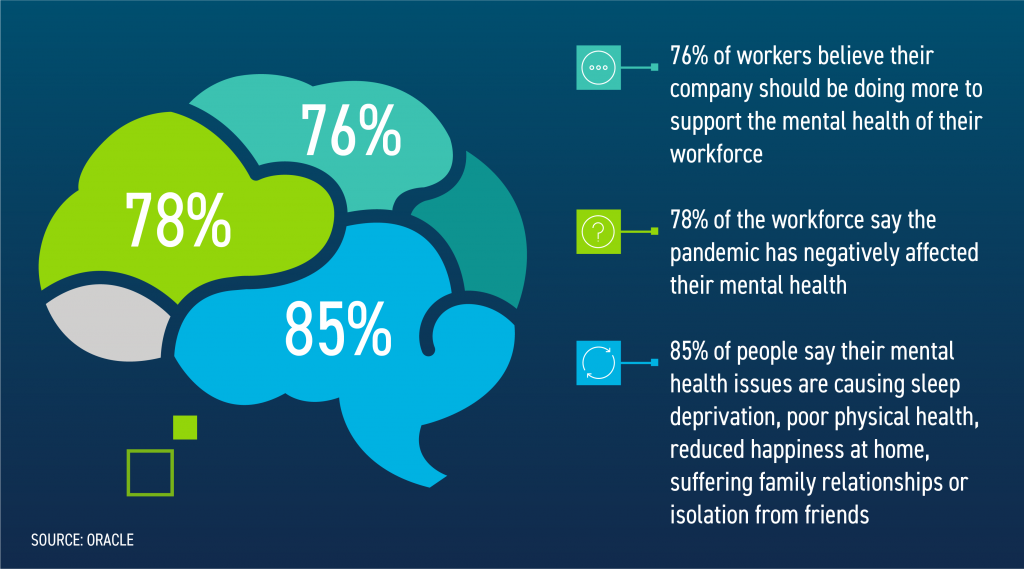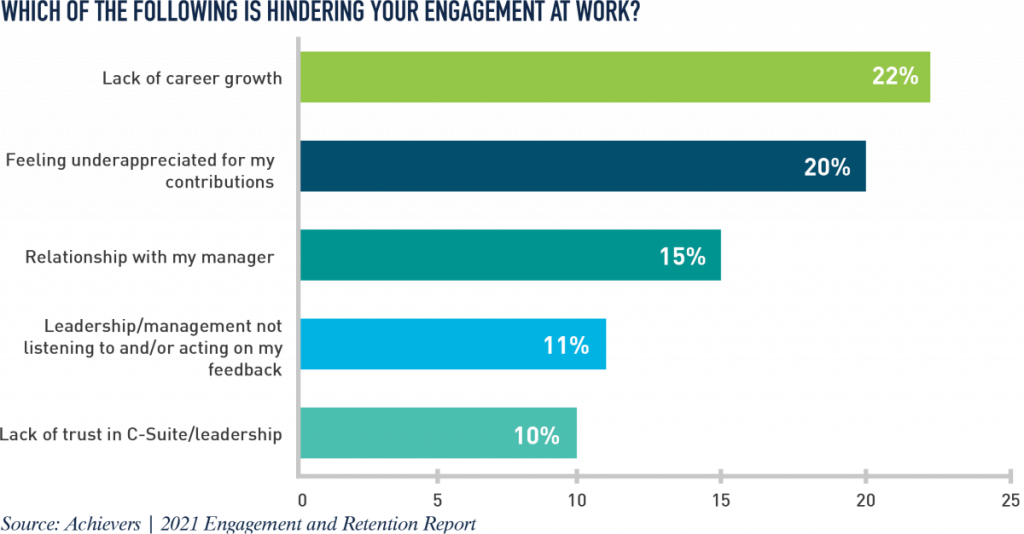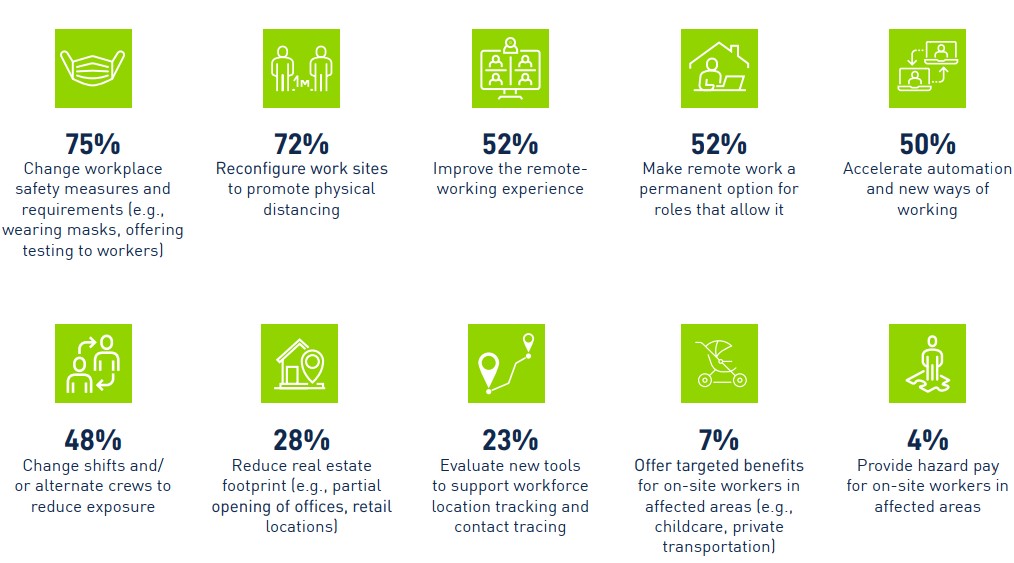Improved employee satisfaction and overall productivity have proven that the new models of flexible work organisations implemented during the COVID-19 pandemic won’t be going anywhere any time soon. In fact, 83% of U.S. companies surveyed by Mercer are considering implementing flexible working at a greater scale than they were prior to the pandemic. In order to improve employee engagement, just as leaders had to adapt to managing remote teams at the onset of the pandemic, they will again need to readjust their approach as they lead teams across a variety of locations, schedules and unique work arrangements.
At PeopleScout, implementing flexible work to support our people is something we know well. One example of this is Emily Gordon, a single mother to a pediatric cancer survivor and PeopleScout’s vice president of global implementation.
In late 2016, when Emily had her final interview before joining PeopleScout, she was sitting in a hospital hallway while her daughter was finishing her fight with pediatric cancer – or so she thought. Emily’s daughter was nine years old when she battled cancer the first time and almost 11 when it returned. As a result, Emily’s goal was to find a company in which she could both work remotely and continue to support her daughter and family. But, prior to COVID-19, there were limited options for people who needed to be adaptable and still work full-time to support loved ones. Thankfully, PeopleScout’s work flexibility options gave Emily that opportunity.
Emily’s team was willing to work with her on video, which enabled her to be in the hospital with her daughter for more than 100 days in a year, while also exceeding work goals and supporting one of PeopleScout’s largest RPO clients. In turn, Emily has been comfortable hiring people who also need flexibility, such as in part-time or split-shift roles. As Emily’s story illustrates, the need for flexible work options exists outside of COVID-19. These unique situations existed before the pandemic and will continue when it eventually passes; it’s up to organisations to have flexible strategies in place to support their workers.
Even with the variety of benefits of workplace flexibility, the management of it is not without its challenges. Chief among them is how to improve employee engagement, especially during COVID-19. When employees cannot safely interact in close quarters, making sure they remain motivated and attentive is not always easy. In this article, we outline tips for how to effectively manage teams and improve employee engagement through the remainder of the pandemic and beyond.
“My team was already leveraging technology and reporting to support communication, and when COVID-19 hit, we amplified that across the whole portfolio. We meet twice a week for up to an hour to just talk, listen, give updates and support one another. All it takes is a willingness to over-communicate. Flexibility does not mean less work or performance. In my experience, it means people work harder to achieve goals because they are grateful for the support and understanding that work is not one-size-fits-all.”
Emily Gordon, VP of Global Implementation
Focus on Communication
Communication was important before and throughout the pandemic, so it’s no surprise that a strong communication strategy is at the top of the list for best practices in the new work reality. Regardless of whether you’re leading in-person teams remotely, leading a remote team while you remain in the office, or a combination of both, frequent communication is paramount.
Specifically, managers should schedule regular check-ins with the team as a whole to quickly solve challenges, share knowledge, and communicate openly about what’s working and what might need improvement. Likewise, one-on-one meetings are also important so managers and employees can share feedback and stay on the same page even if they’re working in different locations. Keep in mind that, because many of these flexible work arrangements are still new, it might take some time to find the right meeting cadence that works for both parties. For instance, while it might start out as a weekly check-in, you may find that one employee prefers ad-hoc calls while another prefers a set schedule to keep them on track. Try to remain as flexible as possible when it comes to these check-ins; they’re crucial for helping employees feel connected and cared for.
Quick Tip: Remember to trust your people and approach communications with a sense of empathy and a people-first focus.
Improve Employee Engagement Through Collaboration
Because employees may be scattered across different locations, working different hours or job-sharing, it can be easy to feel a little disconnected from each other – especially for workers who are not regularly going into the office. Fortunately, leaders can help solve this challenge by leveraging the following tools and strategies that foster collaboration and connectedness across teams.
Create a Team Brief
Your flexible work model may see some people working special hours to care for kids or loved ones, while others are using a hybrid model to work both in the office and remotely on alternating days. To ensure everyone is on the same page, it can be helpful to create a short team brief that outlines key expectations, covers how and when you’ll communicate, and transparently shares each employee’s schedule.
Quick Tip: Utilise tools like Teams and Slack (or your preferred communication platform) to set messages for when you’re away and when you’ll be back online.
Encourage Video Meetings to Improve Employee Engagement
While some employees are working in-person because their job duties require them to or they don’t have the means to work effectively at home every day, others may be fully remote for safety and family obligations. However, if you’re not careful, these employees can easily feel left out because they’re missing out on the face-to-face interactions and impromptu conversations that naturally occur when people work together in the same office.
Quick Tip: Ensure employees have the tools necessary for high-quality video calls, including proper audio and video equipment.
Fortunately, according to OwlLabs, 93% of people agree that video conferencing is effective at improving the connectedness of remote employees. Therefore, encourage calls to be taken on video so virtual workers have the opportunity to view and share non-verbal reactions, as well as their verbal insight. At the same time, pre-determine which meetings will be on video so employees have a chance to prepare. And, to combat video fatigue, be flexible in allowing people to remain off video if it is not conducive for them on a given day.
Quick Tip: Create a digital space where meeting attendees can post thoughts and notes once they’ve reflected on the call. This can give remote employees the chance to contribute to the “meeting after the meeting” that often occurs in person.
To enhance participation in video calls, show people how to ask questions in the chat, virtually raise their hand, and/or use breakout rooms so everyone has a chance to work and connect with one another.
Utilise Shared Dashboards
With people working various hours and in different places, staying aligned on goals and the work that is being done can be a challenge. However, by leveraging available technology, you can create team dashboards that share which projects are currently in progress and who is working on what. This can then give the whole team insight into the work that everyone is contributing, as well as the progress being made toward goals –regardless of when and where they’re working. Digital project management dashboards are also a great way to assign tasks, track targets and share ideas.
Quick Tip: To boost connectedness, create sub-channels within your communication platforms to group individuals with similar professional skills and personal interests.
Build Community to Improve Employee Engagement
It’s important that neither the in-person nor the remote teams become isolated from the other. As a manager, it’s your job to ensure you’re not mistakenly focusing more on one team over the other. To that end, a great way to build team culture and community is to spend some time each month on a virtual happy hour, coffee break or other team-building activity perfect for hybrid teams. Then, when the pandemic is no longer looming over us, it will also be important to make time to see people in-person when possible. For example, if you are traveling to the same location as an office or remote employee, set aside some time to meet them for a cup of coffee or lunch. Or, if you normally have a virtual check-in at the time you’re visiting, conduct your meeting face-to-face.
Quick Tip: To create equity between your remote and in-person teams, try to find unique ways to extend perks to virtual team members, as well. For example, when providing lunch for a meeting at the office, offer your remote workers a gift card for their lunch at home.
Create opportunities for hybrid teams to connect with each other on a personal level. For example, if it’s “bring your kid to work day” in the office, allow remote employees to bring their child to video sessions. This is an easy way to stimulate real connections between colleagues.
Flexible work models are quickly becoming the norm and are already proving to be an integral part of the way we work during the pandemic. The modes of work established in these instrumental months will pave the way for a future of flexible work beyond the current global health crisis. In that future, leaders will need to prioritise communication, collaboration and connectedness to create sustainable team engagement, productivity and culture.













